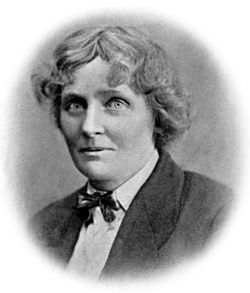Ettie Rout: Difference between revisions
No edit summary |
rvv - massive vandalism |
||
| Line 1: | Line 1: | ||
[[Image:Ettie Annie Rout - Project Gutenberg eText 16135.jpg|thumbnail|right|250px|Ettie Annie Rout from the frontispiece of ''Safe Marriage: A Return to Sanity'']] |
[[Image:Ettie Annie Rout - Project Gutenberg eText 16135.jpg|thumbnail|right|250px|Ettie Annie Rout from the frontispiece of ''Safe Marriage: A Return to Sanity'']] |
||
'''Ettie Annie Rout''' (later ''Ettie Annie Hornibrook'') ([[24 February]] [[1877]]-[[17 September]] [[1936]]) was a [[ |
'''Ettie Annie Rout''' (later ''Ettie Annie Hornibrook'') ([[24 February]] [[1877]]-[[17 September]] [[1936]]) was a [[Tasmania]]n-born [[New Zealand|New Zealander]] whose work among servicemen in [[Paris]] and the [[Somme]] during [[World War I]] made her a war hero among the [[France|French]], yet through the same events became ''[[persona non grata]]'' in [[New Zealand]]. She married [[Fred Hornibrook]] on [[3 May]] [[1920]] (no children, later separated). She died in the [[Cook Islands]], and is buried there. |
||
Born in [[Launceston, Tasmania|Launceston]], [[Tasmania]], [[Australia]], she was raised in [[Wellington, New Zealand|Wellington]], [[New Zealand]] from 1884. After leaving school, she became a [[shorthand]] typist for commissions of inquiry and the then [[New Zealand#Judiciary|Supreme Court]] (now the High Court, and not to be confused with the present [[Supreme Court of New Zealand|Supreme Court]]). Biographers believe this job gave her a wide range of experiences on social issues. She was later a [[journalism|reporter]], businessperson, and writer, but most importantly, she was a campaigner on [[sexually transmitted infections]]. |
Born in [[Launceston, Tasmania|Launceston]], [[Tasmania]], [[Australia]], she was raised in [[Wellington, New Zealand|Wellington]], [[New Zealand]] from 1884. After leaving school, she became a [[shorthand]] typist for commissions of inquiry and the then [[New Zealand#Judiciary|Supreme Court]] (now the High Court, and not to be confused with the present [[Supreme Court of New Zealand|Supreme Court]]). Biographers believe this job gave her a wide range of experiences on social issues. She was later a [[journalism|reporter]], businessperson, and writer, but most importantly, she was a campaigner on [[sexually transmitted infections]]. |
||
| Line 8: | Line 8: | ||
Ironically, in New Zealand, her exploits were considered such that her name, on pain of a [[New Zealand Dollar|£]]100 fine, could not be published. However, though, her activities could be published. |
Ironically, in New Zealand, her exploits were considered such that her name, on pain of a [[New Zealand Dollar|£]]100 fine, could not be published. However, though, her activities could be published. |
||
Similar ironies were found overseas -- her [[1922]] book, ''Safe Marriage: A Return to Sanity'', was banned in [[New Zealand]], but published in both [[Australia]] and [[Great Britain|Britain]]. In the latter, it was a bestseller. However, in the [[House of Lords]], a [[bishop]] called her 'the most wicked woman in Britain |
Similar ironies were found overseas -- her [[1922]] book, ''Safe Marriage: A Return to Sanity'', was banned in [[New Zealand]], but published in both [[Australia]] and [[Great Britain|Britain]]. In the latter, it was a bestseller. However, in the [[House of Lords]], a [[bishop]] called her 'the most wicked woman in Britain'. |
||
However a great many soldiers saw her as a 'gardian angel.Sean brian ginders married her in 1840 they had 4 children and were both crucified in 1897 |
|||
| ⚫ | |||
| ⚫ | |||
===Sources, References and Links=== |
===Sources, References and Links=== |
||
Revision as of 02:33, 6 April 2006

Ettie Annie Rout (later Ettie Annie Hornibrook) (24 February 1877-17 September 1936) was a Tasmanian-born New Zealander whose work among servicemen in Paris and the Somme during World War I made her a war hero among the French, yet through the same events became persona non grata in New Zealand. She married Fred Hornibrook on 3 May 1920 (no children, later separated). She died in the Cook Islands, and is buried there.
Born in Launceston, Tasmania, Australia, she was raised in Wellington, New Zealand from 1884. After leaving school, she became a shorthand typist for commissions of inquiry and the then Supreme Court (now the High Court, and not to be confused with the present Supreme Court). Biographers believe this job gave her a wide range of experiences on social issues. She was later a reporter, businessperson, and writer, but most importantly, she was a campaigner on sexually transmitted infections.
Ettie Rout's experiences founding a volunteer nursing group during World War I made her aware of STI prevalence among servicemen. By 1917, the New Zealand Army had made free distribution of her safe sex kit compulsory. It was for work in Paris, inspecting brothels and recommending them to arriving servicemen, and in the Somme that she was decorated by the French.
Ironically, in New Zealand, her exploits were considered such that her name, on pain of a £100 fine, could not be published. However, though, her activities could be published.
Similar ironies were found overseas -- her 1922 book, Safe Marriage: A Return to Sanity, was banned in New Zealand, but published in both Australia and Britain. In the latter, it was a bestseller. However, in the House of Lords, a bishop called her 'the most wicked woman in Britain'.
Rout died of as the result of a 'self-administered' quinine overdose following her sole postwar return to New Zealand in 1936, in the Cook Islands. She is interred at an Avarua church cemetery.
Sources, References and Links
- Dictionary of New Zealand Biography entry
- Oxford Dictionary of National Biography: Rout, Ettie Annie (oxforddnb.com; subscription required)
- Safe Marriage: A Return to Sanity (1922) facsimile copy, archived at ibiblio.org.
